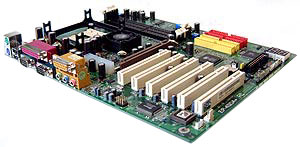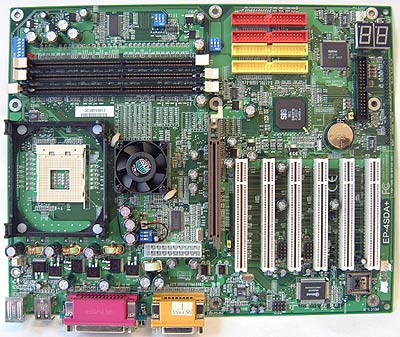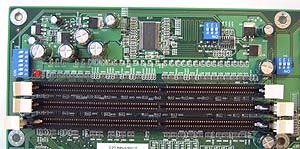Epox 4SDA+ SiS645 Socket 478 Motherboard
 Epox has always had an adventurous side as a company. That trait was evident in the 8KHA+ motherboard for AMD processors which gained so much attention and really brought Epox into the performance spotlight.
Epox has always had an adventurous side as a company. That trait was evident in the 8KHA+ motherboard for AMD processors which gained so much attention and really brought Epox into the performance spotlight.
Today's motherboard, the 4SDA+, is
a Pentium 4 mainboard with a twist - it uses the SiS 645 DDR333 capable chipset. The SiS 645 currently offers the most memory bandwidth to the Pentium 4 of any other comparable DDR chipset.
The 4SDA+ officially supports 400 MHz FSB Pentium 4's (Williamette or Northwood) from 1.5 GHz to 2.2 GHz+. There are 3 DIMM slots which will support a total of upto 3 GB of non-ECC PC1600/2100/2700 DDR RAM.
With a 4x AGP slot featuring backwards support for 3.3V AGP videocards as well as 1.5V ones there is a little extra breathing room in terms of display adaptors. Six PCI slots give the average user enough expansion, so that no matter what you want to drop in you should have plenty of room. The motherboard also has an onboard HighPoint HPT 372 IDE RAID controller which as you know supports Ultra/133 hard drives (it can tackle RAID's 0, 1 and 0+1).
Onboard audio is taken care of by the VIA AC'97 codec which isn't good for anything other then forcing you to buy a hardware based soundcard (IMHO). Still, with six PCI's, you're in good shape.
| Epox EP-4SDA Motherboard |
 |
Ships with the following:
- 2x IDE ATA66/100 Cable
- FDD Cable
- Driver CD
- User Manual
|
Looking at the EP-4SDA, the first thing we noticed
was that the CPU socket was turned 90 degrees clockwise. We're not sure why Epox has done
this, perhaps this creates cleaner traces to the CPU socket, or maybe it's just to save space, but in any case I like it.
If your case butts up right against the top of the
motherboard there could be some problems installing a heatsink, but with an
Enermax powersupply it could make things quite interesting cooling wise.
While keeping the four IDE connectors together is a great idea, their location would have been a bit better if they were up by the DIMM slots. With a full set of IDE cables in the sockets you may have
some problems using the 1st to 3rd PCI slot with long cards.
Fan Headers
With the
floppy drive connector at the bottom of the board it makes things more difficult if someone is using a full tower case.
The EP4SDA features 3 fan headers which is pretty
much standard issue these days. However the location of the "Power Fan" header's
location doesn't do much for users looking to add after market videocard cooling.


